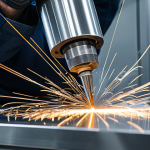Stepping into the world of metal fabrication, you’re quickly faced with a foundational decision: what welding process is right for your project? For many, the choice boils down to two titans: Arc welding, often called Stick welding (SMAW), and TIG welding (GTAW).
I remember my own journey, feeling a bit overwhelmed, trying to figure out which process would truly empower my craft. It’s not just about melting metal; it’s about the control, the finish, and the application.
While stick welding offers incredible brute force and versatility, a true workhorse for heavy-duty tasks even in less-than-ideal conditions, TIG welding represents the pinnacle of precision and aesthetic beauty.
As industries evolve towards lighter, stronger, and more intricately designed components, often leveraging advanced materials and automation for efficiency, understanding the nuances between these two becomes absolutely critical.
So, whether you’re tackling a rugged outdoor repair or creating a delicate, high-tolerance part for a future-forward robotic arm, the right choice makes all the difference.
Let’s delve into the specifics and understand their true capabilities.
The Unyielding Workhorse: Unveiling SMAW’s Robust Reliability

Stepping up to a stick welder, there’s an undeniable sense of raw, almost primal power. I remember my first time striking an arc with an E6010 rod on a rusty piece of angle iron – it wasn’t pretty, but it welded! That’s the beauty of Shielded Metal Arc Welding (SMAW), affectionately known as stick welding. It’s truly the workhorse of the welding world, forgiving and incredibly robust, capable of tackling jobs in conditions that would make other processes falter. Imagine being out in the field, battling wind, rain, or a less-than-pristine surface; stick welding thrives where precision isn’t the absolute top priority but getting the job done is. It uses a consumable electrode coated in flux, and as that electrode melts, the flux creates a shielding gas that protects the molten weld pool from atmospheric contamination. This self-shielding nature makes it remarkably versatile for outdoor work, structural steel, or repairs on dirty or painted metal where other methods would struggle with porosity. You just grab your stinger, clamp your ground, and you’re ready to fuse some serious metal, making it an invaluable skill for fabricators, farmers, and even hobbyists working on rugged projects.
1. Versatility Across Environments and Materials
One of the most compelling advantages of stick welding is its incredible adaptability to diverse working conditions. Unlike processes that require a constant supply of external shielding gas, the flux coating on stick electrodes generates its own protective envelope as it burns. This means you can weld effectively in windy conditions, outdoors, or in environments where setting up gas cylinders would be impractical or unsafe. From my own experience on various job sites, I’ve seen stick welders perform flawlessly in a dusty workshop one day and on a cold, breezy construction site the next. This makes it ideal for heavy structural steel, pipeline welding, ship repair, and even basic farm equipment maintenance. It’s also quite forgiving with surface prep; while you always want clean metal, stick can burn through light rust or paint much better than TIG, saving you significant time on arduous prep work. This resilience truly makes it a go-to for situations where absolute pristine conditions aren’t feasible.
2. Equipment Simplicity and Portability
The beauty of stick welding equipment lies in its elegant simplicity. You essentially need a power source, electrode holder (stinger), ground clamp, and electrodes. That’s it. There are no gas tanks, flow meters, or intricate wire feeders to worry about, which drastically reduces both the initial investment and the ongoing maintenance. I recall putting together my first stick welding setup for a fraction of what a basic TIG rig would cost, and that accessibility is a huge win for anyone starting out or needing a portable solution. Modern inverter-based stick welders are incredibly lightweight, often weighing less than 20 pounds, making them incredibly easy to transport to remote job sites or move around a busy workshop. This portability, combined with the lack of external gas, means you can take your welding capabilities virtually anywhere, from a backyard fence repair to a critical structural fix miles from any shop. It’s the epitome of grab-and-go welding, minimizing setup time and maximizing immediate productivity.
Crafting Perfection: The Finesse of GTAW
If stick welding is the brawler, then TIG welding (Gas Tungsten Arc Welding, or GTAW) is the surgeon. When I first tried TIG, I was intimidated by the foot pedal, the separate filler rod, and the sheer coordination required. But once you get that dance down – the rhythmic push of the pedal, the steady feed of the rod, the precise manipulation of the torch – the results are simply breathtaking. TIG produces welds of unparalleled quality and aesthetic beauty. There’s no spatter, no slag to chip away, just a clean, shiny, perfectly contoured bead that looks like a row of stacked dimes. This process uses a non-consumable tungsten electrode and an inert shielding gas, typically argon, to protect the weld pool. The heat is incredibly focused, allowing for exquisite control over the molten puddle, which is crucial for thin materials or when working with exotic metals like stainless steel, aluminum, titanium, and even nickel alloys. I’ve used TIG to repair delicate automotive components and create intricate artwork, and each time, the precision it offers makes you feel like you’re truly crafting, not just joining.
1. Unmatched Precision and Aesthetic Quality
The hallmark of TIG welding is its extraordinary precision and the superior quality of its finished welds. Unlike other processes, TIG allows for independent control over heat input (via the foot pedal or hand control) and filler metal addition (via a separate rod). This granular control gives the welder the ability to manipulate the molten puddle with incredible finesse, leading to welds that are not only structurally sound but also visually stunning. I’ve spent countless hours meticulously laying down TIG beads, and the satisfaction of seeing a clean, spatter-free, perfectly consistent weld is unparalleled. This clean finish means less post-weld cleanup, saving significant time and labor, especially for applications where aesthetics are critical, such as custom exhaust systems, architectural metalwork, or sanitary food-grade stainless steel piping. The absence of flux or spatter also contributes to healthier fumes compared to stick welding, making it a preferred choice in enclosed environments or for sensitive applications.
2. Exceptional Material Versatility and Purity
While stick welding is great for steel, TIG welding truly shines when it comes to material versatility, particularly with non-ferrous metals and high-alloy steels. It’s the go-to process for aluminum, magnesium, copper alloys, stainless steel, and even exotic metals like titanium and zirconium, which are highly reactive and demand maximum shielding purity. The inert gas shield, usually pure argon, completely protects the weld pool from atmospheric contamination, preventing porosity and inclusions that can compromise weld integrity. I’ve personally used TIG to weld incredibly thin sheets of aluminum for aerospace projects, where even the slightest contamination could lead to failure. This makes it indispensable in industries like aerospace, medical, and semiconductor manufacturing, where material purity and weld integrity are paramount. The ability to weld dissimilar metals, albeit with specific filler metals, further broadens its application, allowing for complex assemblies that would be impossible with other welding methods.
Beyond the Sparks: Understanding Material Mastery
Selecting the right welding process isn’t just about the equipment; it’s profoundly about the materials you’re joining. Different metals react uniquely to heat, current, and shielding, and a mismatch here can lead to frustrating failures. I’ve seen firsthand how trying to stick weld thin gauge aluminum results in a melted mess, or attempting to TIG weld heavily rusted structural steel can lead to extensive porosity and a weak joint. Understanding the metallurgical properties of your base metal—its thickness, its conductivity, its susceptibility to oxidation—is as crucial as knowing how to strike an arc or depress a foot pedal. This material mastery ensures that the weld itself is not just physically connected but metallurgically sound, preserving the properties and strength of the original components. For instance, welding high-carbon steel often requires preheating and post-heating to prevent cracking, a process that can be finely tuned with TIG’s precise heat control. Conversely, for large, thick sections of mild steel, the brute force and deep penetration of stick welding often make it the most efficient and robust choice, minimizing the number of passes required. The best welders aren’t just skilled with their hands; they’re also deeply knowledgeable about the science behind the fusion.
1. Optimal Process for Diverse Metal Types
Each welding process has its strengths and weaknesses when it comes to specific metal types and thicknesses. Stick welding, for example, is fantastic for ferrous metals like carbon steel and cast iron, particularly in thicker sections where deep penetration is desired. Its ability to handle less-than-perfect surface conditions makes it a go-to for field repairs on structural steel or heavy machinery. I once had to repair a broken cast iron bracket on an old tractor, and stick welding with a nickel-based electrode was the only practical way to get it done reliably in situ. On the other hand, TIG welding excels with a broader range of materials, including stainless steel, aluminum, copper, titanium, and even exotic alloys. Its precision and clean arc make it ideal for thin materials that would blow through with stick, or for applications where appearance is critical. For instance, fabricating custom aluminum fuel tanks or delicate stainless steel handrails invariably calls for the nuanced control of TIG, ensuring both strength and a beautiful finish.
2. The Imperative of Cleanliness and Preparation
While stick welding offers some forgiveness, cleanliness and proper joint preparation are absolutely critical for achieving high-quality welds with any process, and especially with TIG. Any oil, grease, paint, or rust can introduce contaminants into the weld pool, leading to porosity, cracking, and a significantly weakened joint. With TIG, where purity is paramount, even fingerprints can cause issues on sensitive metals like aluminum. I’ve learned the hard way that skimping on prep work invariably leads to frustrating rework. For stick welding, simply grinding off heavy rust and scale might suffice for some applications, but for TIG, you’re often looking at wire brushing, acetone cleaning, and even dedicated stainless steel brushes to avoid cross-contamination. The extra time spent on prep work is an investment in the quality and longevity of your weld, reducing headaches down the line. Remember, a beautiful weld starts long before the arc is struck – it begins with meticulous preparation.
The Learning Curve: Your Path to Welding Proficiency
Embarking on a welding journey is immensely rewarding, but it’s important to understand that each process comes with its own unique learning curve. When I first picked up a stick welder, I found the concept of striking an arc and maintaining a consistent travel speed quite challenging. There’s a real art to it, feeling the arc, controlling the puddle, and learning to read the slag. It takes practice, patience, and a willingness to accept some ugly beads before you start laying down anything remotely presentable. However, once you get the fundamentals, stick welding is relatively quick to grasp for basic applications, making it an excellent entry point for hobbyists and those needing robust, functional welds. TIG, on the other hand, is a whole different beast. It demands a high degree of coordination, akin to patting your head and rubbing your belly while hopping on one foot. You’re controlling the torch with one hand, feeding filler rod with the other, and managing the amperage with a foot pedal – all simultaneously! It’s frustrating at first, and you’ll likely spend many hours just practicing puddle control and rod feeding. But the reward for that dedication is the ability to produce truly artful and structurally superior welds.
1. Initial Skill Acquisition and Practice
For many aspiring welders, stick welding often presents a more accessible entry point due to its simpler equipment and a slightly more forgiving nature regarding technique. You primarily focus on maintaining arc length, travel speed, and electrode angle. I remember the sheer joy when my first consistent stick bead finally emerged from beneath the slag – it wasn’t perfect, but it was *there*. The immediate feedback from the arc and the puddle helps in learning. TIG, however, demands a significant investment in motor skills and hand-eye coordination. The precise control of the torch, the delicate feeding of the filler rod, and the nuanced modulation of current with the foot pedal require extensive practice. My initial TIG attempts looked like a drunken snail had crawled across the metal, but with persistent dedication, those wobbly lines gradually transformed into smooth, uniform beads. It’s a journey of continuous refinement, where every hour spent practicing puddle control and rod feeding pays dividends in the quality of your welds.
2. Mastery and Advanced Techniques
While basic proficiency in either stick or TIG can be achieved relatively quickly with diligent practice, true mastery in both processes is a lifelong pursuit. For stick welding, advanced techniques involve mastering vertical-up, overhead, and pipe welding positions, understanding electrode selection for specific applications, and dealing with challenging joint designs. It’s about becoming efficient and consistent in less-than-ideal field conditions. For TIG, the path to mastery is even more intricate, encompassing advanced pulse settings, working with incredibly thin materials, mastering exotic alloys, and executing complex multi-pass welds with precision. I’ve seen seasoned TIG welders create seamless joints on aerospace components that look like they were grown rather than welded. This level of expertise comes from thousands of hours of dedicated practice, troubleshooting, and a deep understanding of metallurgy. Both processes offer endless opportunities for growth, pushing your skills and understanding of material science to new heights.
Counting the Costs: Equipment and Consumables
Beyond the immediate decision of what process to learn, there’s the practical reality of budget. Investing in welding equipment can range from a few hundred dollars for a basic setup to thousands for a professional multi-process machine. I recall the initial excitement of buying my first welder, quickly followed by the realization that the initial purchase was just the beginning. You also need to factor in the ongoing cost of consumables, which can vary significantly between stick and TIG. Understanding these financial commitments upfront helps you make an informed decision, especially if you’re setting up a home workshop or equipping a small fabrication business. While a barebones stick setup might seem like the cheapest entry, the cost of electrodes can add up over time, particularly for specialized rods. TIG, conversely, has a higher barrier to entry with the machine and accessories, but the tungsten electrodes themselves are non-consumable, and only the filler rod and shielding gas are ongoing expenses. It’s a trade-off between upfront investment and long-term operating costs, tailored to your specific project needs and budget constraints.
1. Initial Investment in Equipment
The initial cost of setting up a welding station can vary dramatically between stick and TIG. A decent, entry-level stick welder (SMAW) can often be purchased for as little as $200-$500, making it highly accessible for hobbyists or those on a tighter budget. These machines are relatively simple, robust, and require minimal additional accessories to get started. TIG welding (GTAW) presents a significantly higher initial investment. A basic AC/DC TIG machine capable of welding aluminum will typically start around $800-$1,500, and professional-grade units can easily run into several thousands of dollars. Beyond the machine itself, you’ll also need a gas cylinder (argon), a regulator, a water cooler for higher amperage applications, and a variety of torch consumables, all of which add to the upfront cost. I remember feeling a bit of sticker shock when pricing out my first TIG setup compared to my basic stick rig, but the capabilities justified the expense for the projects I wanted to tackle.
2. Ongoing Consumable Expenses
While the upfront cost might favor stick, the ongoing consumable expenses tell a different story. With stick welding, your primary consumable is the electrode itself. While individual rods are inexpensive, for larger projects or continuous welding, the cost can accumulate quickly. Different types of electrodes are also required for different materials and applications, adding to the variety you need to keep on hand. TIG welding, however, uses a non-consumable tungsten electrode, meaning you reuse the same electrode many times after sharpening. Your main ongoing expenses are the filler rods, which are typically sold by the pound and are quite efficient, and the shielding gas, usually argon. A large cylinder of argon can last for many hours of welding, making the per-foot cost of welding quite reasonable. From my own experience, for consistent, high-volume work, the recurring costs of TIG can often be more predictable and sometimes even lower than continuously buying stick electrodes, especially if you’re not dealing with heavily oxidized or contaminated materials.
Safety First: Protecting Your Craft and Yourself
No matter how skilled you become, safety in welding is non-negotiable. I’ve heard too many stories, and even had a few close calls myself, that serve as stark reminders of the inherent dangers if proper precautions aren’t taken. Both stick and TIG welding involve intense heat, UV radiation, electrical hazards, and potential fumes, each demanding specific protective measures. It’s not just about throwing on a pair of gloves and calling it a day; it’s about understanding the risks and consistently implementing a comprehensive safety protocol. From ensuring proper ventilation to wearing appropriate personal protective equipment (PPE) and maintaining your equipment, every step counts. The brilliant arc from stick welding can cause flash burn in seconds, and the focused heat of TIG can ignite nearby flammables with alarming speed. Prioritizing safety not only protects you from immediate injury but also safeguards your long-term health, preventing issues like ‘welder’s flash’ or respiratory problems from inhaling fumes. Remember, a successful weld is always a safe weld. Never compromise on your well-being for the sake of getting a job done quickly.
1. Personal Protective Equipment (PPE) Essentials
Regardless of whether you’re stick welding a bridge or TIG welding a delicate sculpture, appropriate Personal Protective Equipment (PPE) is your first line of defense. This includes a good quality welding helmet with the correct shade lens for the amperage you’re running – I always recommend an auto-darkening helmet for convenience and safety. Heavy-duty leather gloves are essential to protect your hands from heat, sparks, and UV radiation; thin TIG gloves offer better dexterity but less heat protection, so choosing the right pair is crucial. Long-sleeved, flame-resistant clothing (like a welding jacket made of leather or treated cotton) is vital to prevent severe burns from spatter and UV exposure. I can’t stress enough the importance of sturdy, closed-toe work boots, preferably leather, to protect your feet from falling objects or hot metal. Eye protection, typically safety glasses worn under your helmet, is also critical for chipping slag or grinding. Always remember that even a quick glance at the arc without proper protection can lead to painful and damaging ‘welder’s flash’.
2. Mitigating Hazards: Fumes, Fires, and Electrocution
Beyond personal protection, understanding and mitigating the environmental hazards associated with welding is paramount. Welding fumes, which contain various particulates and gases, can pose significant respiratory risks over time. Always ensure adequate ventilation – ideally local exhaust ventilation that draws fumes away from your breathing zone, or at least excellent general ventilation in your workspace. Confined spaces require forced air ventilation and sometimes even supplied-air respirators. Fire hazards are another major concern: the intense heat and sparks from welding can easily ignite nearby flammable materials. Before striking an arc, clear your work area of anything combustible within a 35-foot radius, and always have a fire extinguisher rated for Class B and C fires readily available. I make it a habit to check the area for hot spots after I finish welding, too. Finally, electrocution is a very real danger. Always inspect your welding cables and equipment for damage, ensure proper grounding, and never weld in wet conditions or with wet gloves. Treat electricity with the utmost respect; it’s the power that creates your weld, but it can also be incredibly dangerous if mishandled.
The Future of Fusion: Adapting to Evolving Demands
The world of metal fabrication isn’t static; it’s constantly evolving with new materials, automation, and ever-increasing demands for efficiency and precision. As an influencer in this space, I’ve seen firsthand how crucial it is for welders to adapt and expand their skill sets. While the fundamental principles of stick and TIG welding remain foundational, their applications are shifting. Automation in welding, often leveraging robotic TIG or advanced pulsed MIG, is becoming more prevalent in large-scale manufacturing to improve consistency and speed. However, this doesn’t diminish the need for skilled manual welders; instead, it refines their role towards more complex, specialized, or repair-oriented tasks that automation can’t easily replicate. Think intricate aerospace components, bespoke architectural pieces, or critical field repairs on aging infrastructure. The rise of new, lightweight, and high-strength alloys in automotive and aerospace industries also pushes the boundaries of welding processes, often favoring the precise control of TIG. Staying abreast of these trends, understanding when to leverage traditional methods, and when to embrace new technologies, is key to thriving in the dynamic landscape of modern metal fusion.
1. Automation and Advanced Materials
The manufacturing landscape is increasingly influenced by automation, and welding is no exception. Robotic welding, often utilizing advanced TIG or pulsed MIG processes, is now common in high-volume production lines, providing unparalleled consistency and speed. This shift means that manual welders often find themselves focusing on more intricate, prototype, or repair work that requires human adaptability and problem-solving. Furthermore, the advent of new materials like advanced high-strength steels (AHSS), aluminum alloys, and composites in industries such as automotive and aerospace demands precise and clean welding techniques. These materials are often sensitive to heat input and contamination, making TIG welding, with its superior control and inert shielding, the preferred, and sometimes only, viable option. I’ve observed workshops where robots handle the repetitive seams, while highly skilled TIG welders manage the complex junctions and custom modifications, highlighting a symbiotic relationship rather than outright replacement.
2. Skill Specialization and Continuous Learning
As the industry evolves, so too must the welder. While a strong foundation in both stick and TIG remains invaluable, the future often calls for deeper specialization. Becoming an expert in a specific niche, such as pipeline welding with stick, aerospace component repair with TIG, or even artistic metal sculpture, can set you apart. Continuous learning is no longer just a recommendation; it’s a necessity. This means staying updated on new welding codes, exploring advanced techniques like orbital welding, understanding the nuances of different filler metals, and even dabbling in design software. I personally make it a point to attend industry seminars and follow leading fabricators online to keep my knowledge fresh. The ability to troubleshoot complex issues, adapt to new material specifications, and effectively use multi-process machines are becoming increasingly important. The modern welder is not just an artisan of fire, but also a lifelong student of metallurgy, technology, and precision.
| Feature/Characteristic | Stick Welding (SMAW) | TIG Welding (GTAW) |
|---|---|---|
| Equipment Cost (Entry-Level) | Lower ($200 – $500+) | Higher ($800 – $1,500+) |
| Consumables Cost | Electrodes (can add up for large projects) | Filler Rods, Shielding Gas (Argon) – Tungsten is non-consumable |
| Material Compatibility | Steel, Cast Iron, some Stainless Steel (thicker sections) | Stainless Steel, Aluminum, Titanium, Copper, Nickel Alloys, Carbon Steel (thin to thick) |
| Joint Quality/Appearance | Rougher finish, slag to chip, more spatter | Pristine, clean, precise welds, no spatter/slag, excellent aesthetics |
| Skill Level Required | Easier to learn basics, harder to master specialized positions | Higher learning curve (requires high coordination), but yields superior results |
| Portability | Highly portable (no gas tank needed) | Less portable (requires gas cylinder) |
| Environmental Tolerance | Excellent for outdoor/windy conditions, less sensitive to surface contaminants | Requires clean conditions, sensitive to drafts (shielding gas) |
| Thickness Range | Good for thicker materials (1/8 inch and up) | Excellent for thin materials, good for thicker materials with higher amperage |
| Typical Applications | Heavy fabrication, structural steel, pipe, repairs, outdoor work, farm equipment | Aerospace, medical, automotive (custom), artistic metalwork, precision fabrication, thin gauge materials |
Closing Thoughts
As we’ve journeyed through the worlds of SMAW and GTAW, it’s clear that neither process is definitively “better” than the other. Instead, the real mastery lies in understanding their unique strengths and weaknesses, aligning the right tool with the right task. Whether you’re drawn to the rugged, forgiving power of a stick welder or the artistic precision of TIG, the path to welding proficiency is a deeply rewarding one. Embrace the learning curve, practice relentlessly, and always, always prioritize safety. The sparks will fly, the metal will fuse, and with dedication, you’ll be creating strong, beautiful joints in no time. Happy welding!
Useful Information to Know
1. Always prioritize safety: Invest in quality PPE – a good auto-darkening helmet, flame-resistant clothing, and sturdy gloves are non-negotiable. Don’t forget proper ventilation in your workspace!
2. Practice, practice, practice: Welding is a hands-on skill that demands repetition. Grab some scrap metal and spend hours laying beads. Consistency and control come with dedicated practice, not just theoretical knowledge.
3. Join a community: Online forums, local welding classes, or even just chatting with experienced welders at a supply shop can provide invaluable tips, troubleshooting advice, and support. Don’t be afraid to ask questions!
4. Start with the basics: While TIG might look impressive, mastering stick welding first can build a strong foundation in arc control, puddle manipulation, and machine setup that will serve you well across all other welding processes.
5. Consider your long-term goals: If you envision tackling diverse projects in the future, a multi-process welder might be a wise investment down the line, offering the flexibility to switch between SMAW, GTAW, and even GMAW (MIG) on a single machine.
Key Takeaways
Choosing between Shielded Metal Arc Welding (SMAW/Stick) and Gas Tungsten Arc Welding (GTAW/TIG) depends entirely on your project’s demands, materials, and desired weld quality. Stick welding offers unparalleled portability, cost-effectiveness for entry, and robustness in challenging environments, making it ideal for thicker steels and field repairs. TIG welding, conversely, provides unmatched precision, aesthetic appeal, and versatility across a wide range of materials, including thin gauges and exotic alloys, albeit with a steeper learning curve and higher initial investment. Ultimately, success in either process hinges on continuous practice, a deep understanding of material science, and an unwavering commitment to safety protocols. The modern welder’s journey is one of ongoing skill refinement and adaptability to evolving industry needs.
Frequently Asked Questions (FAQ) 📖
Q: Given that both Stick and TIG welding are foundational, how do you really decide which one is the right fit for a specific project?
A: Oh man, this is the million-dollar question, isn’t it? I remember staring at a project, just trying to wrap my head around whether I needed the sledgehammer or the scalpel.
It really boils down to the material, the environment you’re working in, and the kind of finish you’re chasing. If I’m out in the field, maybe fixing a rusty trailer hitch on a farm or putting together a heavy-duty frame for a truck, Stick welding – that trusty SMAW – is my go-to.
It’s incredibly forgiving on dirty or prepped-poorly metal, handles wind and rough conditions like a champ, and honestly, the equipment is way simpler to lug around.
But if I’m back in the shop, meticulously crafting, say, a custom stainless exhaust system for a performance car, or fabricating delicate aluminum components for an aerospace prototype, there’s no contest.
TIG, with its precise heat control and the ability to work with super thin materials and exotic alloys, gives you that unparalleled clean, beautiful bead.
You’ve got to be more patient, sure, but the results speak for themselves.
Q: You mentioned Stick is a “brute force workhorse” and TIG is the “pinnacle of precision.” Can you elaborate on the practical implications of these differences in a typical shop setting or even a home garage?
A: Absolutely. Think of it like this: If you’re building a fence, fixing a structural beam in a barn, or even just repairing some heavy cast iron, Stick welding is your best friend.
It’s robust, it penetrates deep, and it gets the job done without much fuss. You can lay down a serious amount of metal quickly, and honestly, sometimes you just need that power.
My buddy, who runs a general fabrication shop, swears by his stick welder for quick, strong repairs on anything from dumpsters to heavy machinery. But when you walk into a custom fabrication shop that focuses on high-end art pieces, medical equipment, or performance race parts, you’ll see the TIG machines humming.
The control you get with TIG – manipulating the heat input with a foot pedal, using separate filler rod – it’s almost surgical. You can weld incredibly thin gauge materials without blowing through, and the weld itself is so clean and smooth that often it barely needs grinding or finishing, saving a ton of time on the back end for aesthetic jobs.
It’s the difference between a rough carpentry hammer and a jeweler’s finest chisel.
Q: The text hints at industries evolving towards “lighter, stronger, and more intricately designed components.” How does this shift influence the choice between Stick and TIG, particularly for someone looking to future-proof their skills?
A: That’s a sharp observation, and it’s something I’ve seen play out in real-time. When I first started out, stick welding was king, especially for heavy structural stuff.
And it still has its place, absolutely. But as manufacturing pushes for lighter, stronger materials like specialized aluminum alloys, titanium, and various stainless steels – often in thinner gauges or with extremely tight tolerances – TIG welding has become indispensable.
Think about modern aerospace, advanced robotics, even high-end automotive manufacturing; they demand welds that are not just strong but also flawless in appearance and integrity, with minimal distortion.
Stick welding, while powerful, often leaves a rougher finish and introduces more heat, which can warp those delicate, advanced materials. So, if you’re looking to really future-proof your craft, investing time in mastering TIG is a no-brainer.
It opens doors to working with those high-tech, high-value materials and intricate designs that are defining tomorrow’s products. It’s like learning to code in Python when everyone else is still stuck on Fortran; it just positions you better for what’s coming next.
📚 References
Wikipedia Encyclopedia
구글 검색 결과
구글 검색 결과
구글 검색 결과
구글 검색 결과
구글 검색 결과




